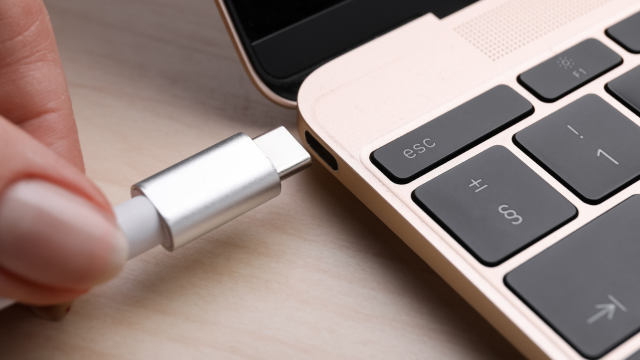I’m going to let you in on a little secret, dear reader: you don’t typically need to use the exact charger that came with your laptop if you don’t want to or if it is broken.
As we’ve written in the past, laptops that come with chargers that aren’t designed with a dedicated USB-C charger can often be charged through a USB-C port separate to the primary charging port.
By way of continuing this thought just a little bit – whatever charger your laptop came with out of the box, it can likely be replaced by a different one.
Can I charge a laptop using a different charger?
Let’s start by talking about voltage. If the laptop charger your device came with has a different output voltage to the one you’re using, then you may damage the device (although USB-C charged laptops are not included in this point, as you’ll read below). You can typically check the original charger’s voltage on the back of the power brick or online, but you should not disregard this point – it could genuinely destroy your device. Voltage standards tend to change from manufacturer to manufacturer, though 12V and 19V are the most common voltages these days. Make no mistake: you need to check your particular charger.
Wattage, however, can vary beyond your laptop’s maximum supported amount. Your machine won’t charge any faster, but it won’t break the device.
Let’s move on to USB-C, which will become the standard laptop charger plug type in Europe by 2026 (so expect to see a lot more of it). USB-C can offer power delivery of up to 240W, which covers the bases of charging most laptops, which tend to stick between 40W and 150W.
As long as the USB-C charger you’re using is being serviced by a cable and plug with a high enough wattage to meet your laptop’s required amount, it should charge your laptop. A phone plug typically won’t have a high enough wattage – Google, Samsung, and Apple’s phone wall plugs offer a maximum of 30W, 45W, and 20W respectively, far below what many laptops will require charger-wise. If you’re using a USB-C cable with Power Delivery support, then you don’t need to worry about voltage; both ends of the cable will agree to service (and be serviced by) a higher voltage, eliminating concerns of damage. Most C-to-C cables and chargers from reputable companies will come with Power Delivery support, although be cautious of low-quality cables.
Moving on to other laptop plug types, many laptops tend to use circle-style charging plugs that vary in diameter, and the voltage and wattage can be different from plug to plug.
Generally speaking, for these plugs, you’ll need to check that the power supply is capable of the same required wattage as your laptop’s original power supply. If your laptop’s original power supply had a 30W output, then whatever charger you use will need to at least match this. Of course, you’ll also need to make sure the plug actually fits into the power port of your laptop, and again, don’t forget about voltage.
For some Apple computers, MagSafe is treated as the primary charging port (though, if necessary, these laptops can charge via a ThunderBolt USB-C port). As Apple laptops are the only computers that use these connectors, you can feel pretty safe expecting the wattage to match the charger, but of course, be careful when shopping for a charger so you don’t end up with a product from a dodgy manufacturer (also, there are physical differences between MagSafe 1, 2, and 3).
Finally, things are a bit more messy when we talk about mobile workstations and gaming laptops. These much more powerful laptops, which draw heaps of power when energy-hungry components like the graphics card are working, require chargers with wattages around the 300W mark. If you’re not using the in-box charger, you’ll need to make sure its replacement is just as powerful to get the same high charging speeds and graphics card capability.
Yes, you can absolutely use a different charger to what your laptop came with, but there are some necessary caveats to this that you need to be aware of. Not every charger will work, and before you purchase another charger, know the wattage, voltage, and plug type that your current laptop needs to use.
